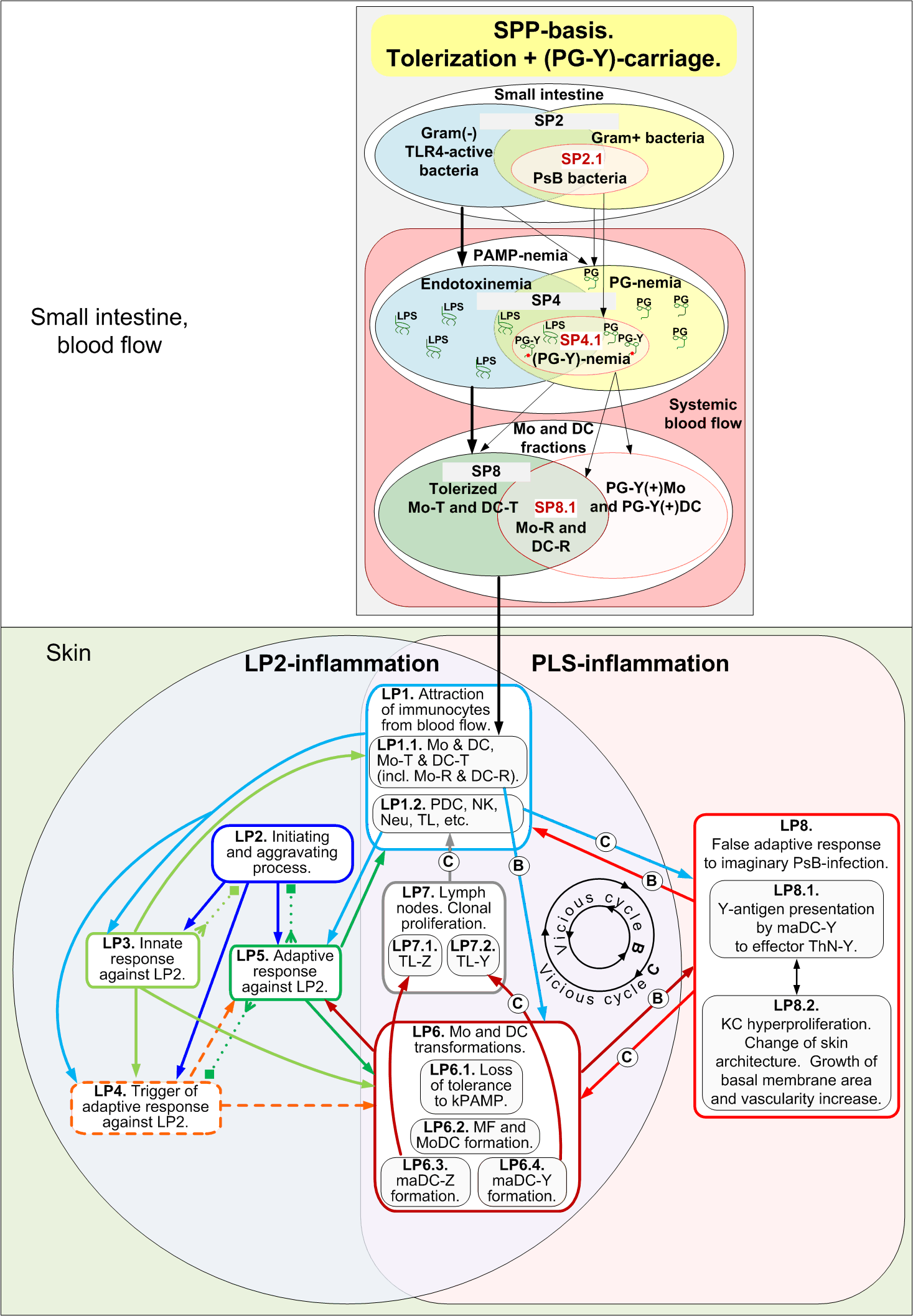Abstract to "Model of pathogenesis of psoriasis. Part 1. Systemic psoriatic process."
Download this e-book on English free (pdf-format).
Review and analytical study of results of experimental and theoretical works on etiology and pathogenesis of psoriatic disease was conducted. Psoriasis is dermal implication of systemic psoriatic process (SPP). New model (hereinafter Y-model) explaining results of clinical and laboratory experiments was formulated. According to Y-model there are two main factors: hyperpermeability of small intestine for bacterial products and colonization of its walls by Gram+ bacteria (incl. psoriagenic bacteria PsB) and Gram(-) TLR4-active bacteria. Inside SPP there is a vicious cycle which is supported by disturbance of production and-or circulation of bile acids.
SPP central subprocess is PAMP-nemia, namely chronic kPAMP-load on blood phagocytes (neutrophiles, monocytes and dendritic cells). The load results in increase of blood kPAMP level. The major key PAMP (kPAMP) are LPS and PG (incl. PG-Y – peptidoglycan of psoriagenic bacteria). Chronically increased kPAMP-load possibly provides tolerization of some neutrophils Neu, monocytes Mo and dendritic cells DC in blood flow.
The chemostatus of tolerized blood Neu-T in process of their aging changes similarly to chemostatus nonactivated Neu and, hence, they carry endocytosed content from blood flow into the bone marrow. Chemostatuses of tolerized Mo-T and DC-T are similar to nonactivated ones. So they don’t bring endocytosed content to lymph nodes or spleen and remain in blood.
Tolerized phagocytes degrade endocytosed fragments of bacterial products containing kPAMP slowly and incompletely. Tolerized phagocytes appeared to be (PG-Y)-carriers are named by R-phagocytes and are designated as Neu-R, Mo-R and DC-R.
SPP severity predetermines possibility of psoriasis initialization and maintenance because Mo-R and DC-R along with normal Mo and DC participate in homeostatic and inflammatory renewal of pool of dermal macrophages and DC of non-resident origin. Mo-R and DC-R enter derma and they can transform to mature maDC-Y (in particular – to TipDC), presenting Y-antigen to specific TL-Y. Local processes in derma and epidermis will be described in details in the second part of the monograph.
Abstract to "Model of pathogenesis of psoriasis. Part 2. Local processes."
Download this e-book on English free (pdf-format).
Observational and analytical research of results of experimental and theoretical studies on etiology and pathogenesis of psoriatic disease is carried out. The new model of pathogenesis of psoriasis – skin reaction to systemic psoriatic process SPP is formulated.
Because of PAMP-nemia in blood flow fractions of tolerized monocytes Mo-T and dendritic cells DC-T are formed. Tolerized Mo-T and DC-T also are kPAMP-carriers. Within the limits of PAMP-nemia also (PG-Y)-nemia takes place. Therefore in tolerized fractions subfractions of monocytes Mo-R and dendritic cells DC-R are formed. These Mo-R and DC-R also are (PG-Y)-carriers. Tolerized Mo-T and DC-T (incl. Mo-R and DC-R) have chemostatuses similar to nonactivated ones. Therefore these cells participate in homeostatic and-or inflammatory renewal of pool of dermal macrophages and dendritic cells of non-resident origin.
Psoriatic inflammation is regarded as a reaction of the skin immune system to activity of Mo-R and DC-R involved in derma from blood flow. They contain Y-antigen and, getting to derma, can be transformed in mature maDC-Y and present this antigen to Y-specific T-lymphocytes as well as activate them. Y-antigen is a part of the interpeptide bridge IB-Y. Therefore, the skin immune system can incorrectly interpret Y-antigen presentation as a sign of external PsB-infection and switch one of mechanisms of protection against bacterial infection – epidermal hyperproliferation.
Psoriatic plaque can be initiated only during action of local inflammatory process LP2 in derma causing not only innate, but also adaptive response. In particular, it is possible at LP2(IN) - open trauma of derma or at LP2(HPV) - HPV-carriage of keratinocytes. The level of Y-priming (presence and concentration of Y-specific T-lymphocytes in prepsoriatic derma and in lymph nodes) also determines possibility of psoriatic plaque initiation.
Existence and severity of psoriatic plaque is determined by intensity of Y-antigen income into derma (inside Mo-R and DC-R). Severity of plaque is aggavated by intensity of kPAMP income into derma (inside Mo-T and DC-T). Intensity of both incomes depends on SPP severity.
Severity of plaque is aggravated by LP2-inflammation if it persists after this plaque initiation. New Mo-T, DC-T (incl. Mo-R, DC-R) and Y-specific T-lymphocytes are constantly attracted into plaques from blood flow, and so support vicious cycles. Only at decrease of SPP severity, these vicious cycles weaken and natural remission of plaques takes place, up to their complete disappearance.
The detailed analysis comparing the new model of pathogenesis with five other previously published models is carried out.

Y-model of pathogenesis of psoriasis. The summary scheme of dependencies.
Above
(fig. 8 from Part 1, e4.0):
Basis of systemic psoriatic process SPP.
Obligatory subprocesses SP2, SP4 и SP8.
Two components of SPP-basis: tolerization of phagocytes и (PG-Y)-carriage of phagocytes.
PsB are E.faecalis, Str. pyogenes, VGS, Str.agalactiae, and also some from Bifidobacterium spp.
LPS - lipopolysaccharide; PG - peptidoglycan; PG-Y - PsB peptidoglycan;
Mo-R and DC-R are PG-Y(+) tolerized Mo-T and DC-T.
Below
(fig. 2-6 from Part 2, e1.3):
Initiating and aggravating process LP2 is not specified.
Interaction of local processes.
PLS-inflammation = inflammation in psoriatic plaque.
Shaped lines - transit process LP4 and the influences bound to it.
Dotted arrows with small squares - suppression. Letters B and С - vicious cycles.